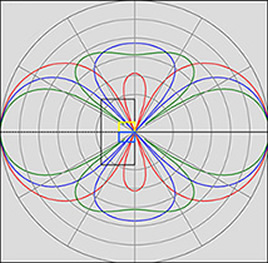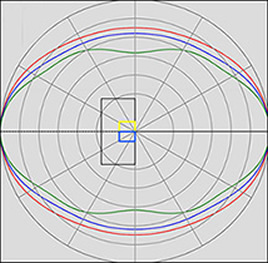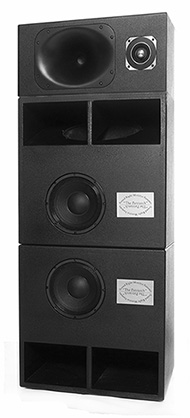Reviews
Read what some of the leading reviewers said about some of
David’s designs!
the amount of low bass energy
this speaker can produce is astounding..
is up there with the
established big boys, ATC, Genelec, PMC and the rest..
Hugh Robjohns
..an optional, I would
suggest imperative extra is on site analysis and alignment of the
system..
the
results were most impressive, exhibiting delicacy and presence
conveying the subtle detail..that few boxed loudspeakers can equal
Ivor Humphreys
"there
was absolutely no hint of either compression or distortion, just
limitless power coupled with lightning speed"
David Allcock
Other Links
Peter Mapp article
and others, Look here.

|
It is possible to use the stack as shown in the picture with the horn box mounted on top of the dipolar array. Another arrangement with the bass/mid cabinets arranged adjacent to each other is described below.
Due to the physical distance between the two midrange drivers on this vertical arrangement, when the same signal is fed to each, the upper crossover point is restricted to 470Hz before lobing and interference patterns are created. The drivers no longer act as a single unit with the result that the listener may perceive different sound quality depending on their off axis listening position.
If the upper crossover point could be extended to around 800Hz it would be possible to use the horn box on top as shown. Unlike the studio monitor this arrangement is for larger venues and the vertical displacement between the horn box and midrange drivers is less problematical, particularly if the stack is time aligned and the dispersion of the midrange is without detrimental lobing and comb filter response patterns. The horizontal dispersion remains that of a single loudspeaker driver.
Of course an even bigger horn with a 2” throat could be employed and the P. Audio/JBL 2380a comes to mind. This horn not only physically fits perfectly on the stack but will crossover comfortably from around 600Hz upwards, some 200Hz off it’s cut off frequency and a comfortable crossover point for the vast majority of suitable larger compression drivers, particularly when used with 24dB/octave crossovers. |
The solution to the vertical midrange dispersion problem at higher frequencies is relatively simple and is achieved by applying eq to each midrange driver. The first plot shows the likely dispersion pattern of an uncorrected pair of midrange drivers in the band of interest, 500Hz to 800Hz. From 470Hz down the pattern is without lobing which is clearly not the result above 500Hz!
The horizontal dispersion remains that of a single driver in each case but the improvement in vertical dispersion is dramatic when eq is applied (second polar response plot). A simple shelving eq is applied to one driver to create a –6dB at 800Hz and another eq is applied to provide +6dB at 800Hz for the other driver. This is a gentle slope with a –3dB at around 500Hz. The combined amplitude response should remain the same as two uncorrected drivers.
 |
Vertical dispersion pattern type of the two Patriarch midrange drivers in dipolar array configuration when used without eq, showing the frequencies, Red : 500Hz,
Note the lobing which would result in response anomalies, particularly off axis. The dispersion pattern is free of this lobing below 470Hz, the highest recommended frequency of use if used without the application of eq.
|
|
 |
This is the predicted scale of improvement possible with the application of the simple eq measures described above! Graph colours the same as before.
The vertical dispersion is now balanced right up to 800Hz permitting the use of the Sound Right Patriarch Top Horn Box or even larger horns that could be used from 600Hz upwards.
Not only is the response vertically now without lobing but it also has a measure of vertical control reducing the impact of interference from floors and ceilings.
|
How about side by side?
It is also possible to sit the bass/mid cabinets next to each other as they are manufactured in mirror image pairs. This has the benefit of combining the bass mouth areas but places the two 10” midranges a little further apart when compared to the vertical stack configuration. Without eq the maximum frequency the midrange units can be used to drops to 325Hz but applying eq provides the same improvement as the vertical configuration permitting frequencies up to 800Hz to be used.
The controlled dispersion is now in the horizontal plane with “single” driver vertical dispersion, the opposite of the vertical stack. The horn box or other loudspeaker types can be placed on top of the pair of cabinets or flown with correct delays applied. The potentially reduced height of this loudspeaker arrangement may be more appropriate in smaller venues and there is also an added benefit that a small delay (around 1ms) may be applied to the outer pairs of 15” bass sections providing a more even bass response throughout the venue.
Sound Right is confident that it has the knowledge, products, product recommendations
and experience to create a sound system that is right for your needs, either fixed installation or live venue.
Be kind to ALL your listeners and ensure that they get a good sound whatever position they are listening from..Sound Right can create this for you with its modular, scalable systems!
